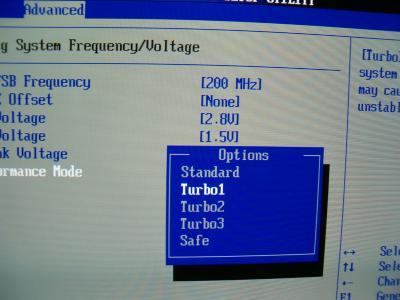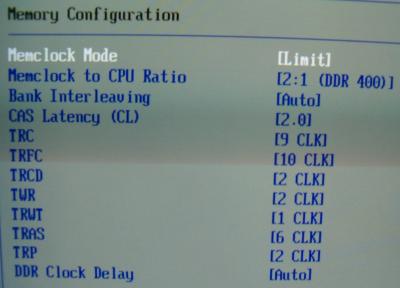BIOS
Being ASUS, it's an AMI BIOS, rather than the AWARD version that almost everyone else uses. I've been a critic of it in the past and I still think it could be easier to navigate with the keyboard, but after using the K8V, I'm warming to it slightly. Like the SK8N, it animates the 'AMI BIOS' string at the top of every page, scrolling it from left to right. Distracting as you try to set 300MHz driven clock, 20x multiplier and 2-1-1-1 memory timings for that monster 3DMark score.The BIOS as shipped was version 1002.007 and that's the version I tested with. 1003 offers multiplier adjustment on top of 1002, giving you access to the 9x multiplier as well as the 10x that Model 3200+ uses. Given that there's no real performance difference and the 1002.007 has some interesting differences in a couple of settings, compared to 1003, 1002.007 was used. You get software adjustment of multiplier (FID) using ClockGen on most K8T800 boards, should your BIOS not give you multiplier adjustment. K8V is supported.
There seems to be some disagreement over unlocking Athlon 64. I could be wrong, but Athlon 64 is required to be multiplier adjustable, while the CPU is running, to support Cool and Quiet. Cool and Quiet is AMD's branch off of PowerNow, their power management interface in certain hardware products. C&Q adjusts CPU speed while the machine is running, using the multiplier, to conserve power. It also changes CPU supply voltage and the CPU fan speed too, to achieve the same goals. C&Q is a BIOS choice on K8V, but it doesn't seem to be implemented fully. Xbit Labs' review of Athlon 64 Model 3200+ shows C&Q working, adjusting CPU speed all the way down to 800MHz (4 x 200), with 1800MHz (9x multi) being the other intermediate step, with voltage changing too.
On the sample K8V boards I have, using 1002.007, it doesn't appear to ever change CPU frequency or voltage when enabled, although fan speed definitely does change. When idle, the PIB fan would completely stop. This suggested CPU frequency was being altered, I wasn't convinced it would just passively cool the CPU at 2000MHz, 1.55V. CPU-Z, my CPU monitoring tool of choice, showed no realtime adjustment of voltage or frequency though.
Whatever happens, even if your BIOS doesn't expose changing of the multiplier, and that multiplier IS locked above the boot multiplier of the CPU (you can't adjust it over 10x on Model 3200+), there is definite adjustment lower down the range. Try ClockGen on your K8T800 board and see. There are some reports of CPUs being locked in this regard too, so AMD might be locking chips from having their FID adjusted outside of the C&Q interface. My PIB Model 3200+ is entirely receptive on K8V however.
K8V Turbo Setting
That brings me nicely on to a section of the BIOS under the Advanced menu.
In the section of the BIOS that lets you adjust the driven CPU frequency, CPU voltage (as an offset of default) and memory voltage, amongst other things, there's an entry called Performance Mode. It's shown in the photo above. With 1002.007, the choosable options give the following CPU settings.
| Standard | 10 x 200 |
| Turbo 1 | 9 x 223 |
| Turbo 2 | 10 x 205 |
| Turbo 3 | 10 x 201 |
Memory latencies are adjusted too, the Safe option in particular sets a really relaxed set with 1002.007, but in the main it's the CPU settings that get changed.
It was a surprise to test Turbo 1 and find it running at 9 x 223. Given K8V's unwillingness to run at certain memory latencies, it was fortuitous that the test memory modules were fine at 223MHz, 2-2-2-6. I've benchmarked the K8V with Turbo 1 at 9 x 223, you'll see the results on the benchmark graphs.
Other BIOS' tested on other K8V's I have access to (1002.009 and 1003 final) offer a different set of frequencies for the Turbo options, so your retail samples will vary depending on BIOS version.
Note that K8V (nor any other K8T800 board I'm aware of) doesn't lock the primary PCI bus or AGP frequencies. Despite hope that a new divider might kick in at 233MHz, it doesn't on either K8V I have, nor an Albatron test board in for review. A downside to overclocking Athlon 64 for sure. With the test hard drive, anything over 225MHz would bring PCI out of spec enough to cause data corruption. The Promise controller runs on the locked secondary PCI bus, use that if overclocking seriously, although watch out for the increased AGP frequency.
Overall
I've used up my page word count talking about multiplier adjust and the Turbo settings, so here's a brief rundown of everything else in there, along with some links to some BIOS photographs.Voltage adjust is limited to CPU and memory, with CPU allowing you 0.3V above default. In practise, that was about 1.75V under load, rather than the 1.85V it ought to be. Slight undervolting there. Memory voltage adjust ranges from 2.5V to 2.8V in 0.1V steps. I'd have liked 2.9V as a choice for some stubborn and obscure modules that are out there, but 2.8V is a decent maximum for most. It seemed to be bang on 2.8V too. AGP voltage is also adjustable, but it's mostly extremely pointless to move it from 1.5V default.
You can adjust HyperTransport frequency, but it had no measurable difference in performance for me. Maybe K8T800 is locking it at 800MHz, and rightly so I feel. Why adjust it and possibly castrate performance under heavy loads?
Full memory timing adjustment is present, exposing some timings that aren't usually exposed in other BIOS'. CL, Tras, Trcd, Trp, Trc, Trfc, Twr and Trwt are all changable, along with a setting named DDR Clock Delay. Here are the tested memory settings. Note DDR clock adjustment (derived from HT clock) and bank interleave adjustment, a setting that's mostly redundant in many common memory configurations and application loads.

They were the most stable module latencies during testing and also the best performing. They fit in nicely with the latencies used in most HEXUS reviews and are the recommended settings for the Corsair memory used.
You get full control over the SATA hardware on the board, and the other onboard devices too. FireWire controller, Ethernet controller and legacy I/O hardware is all available for control in the BIOS. It's pretty comprehensive. Here's a few pictures to round the page off.
Click for picture of the BIOS showing 1800MHz CPU clock, as 9x multi was used (~11KB)
Click for picture of the BIOS Advanced menu (~21KB)
Click for picture of the BIOS version (~5KB)
Click for picture of the Cool & Quiet setting (~9KB)
Click for picture of the Hardware Monitoring section (~16KB)
Click for picture of the HyperTransport bus options (~16KB)
Click for picture of the memory clock options (~23KB)
Click for picture of the onboard device adjust (~17KB)
Click for picture of the core tweaking options (~15KB)









